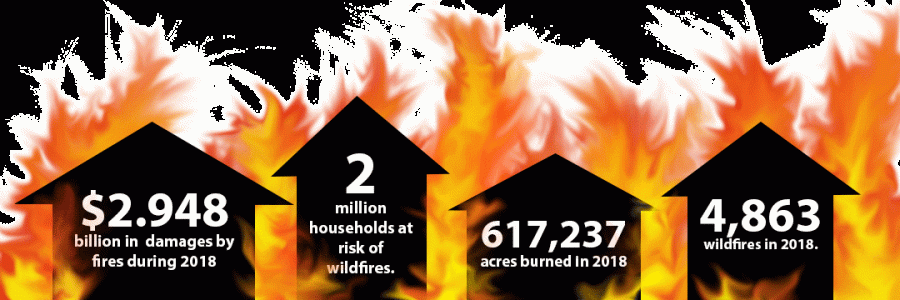New California bill combats recent wildfires
October 5, 2018
Nearly a year after deadly wildfires blazed through Northern California in October 2017, state lawmakers have sent a bill to Governor Jerry Brown’s desk that will affect how the damage caused by future wildfires will be paid. Senate Bill 901 (SB 901) allows utility companies such as Pacific Gas and Electric Company (PG&E) to pass on liability costs to customers, preventing such companies from going bankrupt and customers from suffering a loss of electricity. However, this has led to accusations of lawmakers attempting to bail out utility companies from their responsibilities of resolving the wildfires they’ve caused.
Twenty-one large wildfires destroyed more than 8400 homes and the lives of countless citizens in Napa, Lake, Sonoma, Mendocino, Butte and Solano Counties. English teacher Kristy Harlin, whose family was living in Santa Rosa at the time of the wildfires, was affected by these fires.
“My parents and my brother evacuated at 3 a.m. in the morning, and that was because they didn’t get an alert or anything. The winds were super strong, and my dad woke up because he smelled fire. They looked out the window, neighbors were starting to get in their cars and leave and everything was glowing,” Harlin said. “While our house was fine, a lot of our family friends, neighbors and former classmates lost their houses.”
Some students, like junior Chap-Lum Lau, had family in wildfire regions as well.
“Last year, there were wildfires, so there was smoke that got to us, and the air got really bad, and it always smelled like smoke,” Lau said. “There were also wildfires in Southern California, where my sister lives, so I got a bit worried for her.”
On June 8, the California Department of Forestry and Fire Protection found that many of these deadly wildfires could be attributed to power lines of utility companies, such as trees falling into lines, failure of power poles and malfunctioning power lines. PG&E, in particular, has found itself with a potential of $17 billion in liability costs that could push the company into bankruptcy, leaving its customers with the bulk of the debt. In order to prevent bankruptcy, SB 901 enforces that the California Public Utilities Commission perform a stress test on how much the utility company can pay before passing on costs to ratepayers.
While some officials believe that this bill would be beneficial to the public, others believe that state legislature is giving into the lobbying of utility companies to let them off for the damage of the wildfires. Still, others believe that PG&E is not all to blame.
“I do think PG&E holds a certain level of responsibility, but I also think that at this point, with the environment here, fires are a risk that we have as Californians, living in a dry area,” Harlin said. “We did not have any rain, and we had all this dry brush, and then we had 70 miles-per-hour winds; it was just all these different things that made this happen. To put it all on PG&E is trying to oversimplify the issue.”
Santa Clara County Fire Department’s Fire Captain and Public Information Officer, Bill Murphy, agrees that the cause of the recent large, devastating wildfires is multifaceted.
“You’ve got fuel and weather conditions that have created conditions that are right for very extreme fire behavior,” Murphy said. “You also have land with lots of overgrown vegetation, or fuel, that is built up in many areas for a variety of reasons, one of those being that we have had very active fire suppression over the last hundred years or so, to the point that natural fire had not taken place, and land and management policies and other factors have contributed to that.”
Other aspects the bill covers include streamlining the process of cleaning forest debris, such as dead trees and brush, which fuel wildfires, having been left unchecked in the years absent of wildfires.
“PG&E is a monopoly, so if it goes out of business, then we won’t have any electricity. The bill also says that the money that PG&E saves from this bill won’t be able to go to their employees; it has to go to being more secure, making sure there won’t be any future events or wildfires happening, and for people to come in and make sure that their electricity poles are not in a dangerous place,” Lau said. “They’re making actions to make sure that a future wildfire is less probable.”
SB 901 also gives grants to projects already in place combating wildfires.
“[The bill] is significant legislation that has been passed to help address the wildfire risk,” Murphy said. “Senate Bill 901 actually sets aside nearly nearly a billion dollars over the next five years for risk reduction projects to reduce fires threatening California. So it’s a significant commitment at the state level to work with local government to reduce the risk directly in the communities that are affected.”
The Santa Clara County Fire Department has spearheaded an effort with many other agencies in response to the wildfires, called the Community Wildfire Prevention Plan (CWPP), which it hopes will be completely adopted by all communities in Santa Clara County that face the risk of a wildfire.
“It’s a comprehensive planning document that takes a community by community approach to identifying the wildfire risk for each specific community. It also identifies the types of projects that we can undertake to reduce that risk.” Murphy said. “Based on my understanding of SB901, because we have a Community Wildfire Protection Plan already completed, it means that we have taken the time in this county to assess our wildfire risk. SB 901 specifically prioritizes communities with completed plans when determining who gets funding to complete the projects.”
In other words, while on the surface, the bill may seem to be bailing out utility companies and allowing wildfires to persist throughout California, in truth the bill is providing many measures to combat wildfire risk.
“There are many stakeholders involved in reducing the wildfire risk, the community, state and local agencies, but SB901 provides significant funding to address the problem,” Murphy said. “Locally, in Santa Clara County, the conversation started a few years back with the Community Wildfire Prevention Plan (CWPP) process. So with the passage of SB901 we should be in a position to take advantage of this significant legislation. We now need to work with the community and our partner agencies to prioritize the projects and then secure funding through SB901 to address the risk to our local communities.”
The bill has both its benefits and disadvantages, but in the end it is a step, whether misguided or not, towards combating the prevailing issue of wildfires.




























































